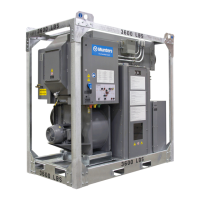Manual# I27028 6-5 Rev. 2 – 11/22/2017
Checking the pressure drop is described in Section 4 - INSTALLATION.
To check for moisture damage and plugging, do the following:
1. Shut down the dehumidifier. Turn off the power at the disconnect switch and follow
lock out/tag out procedures.
2. Remove the wheel as described in Section 6.5.
3. Check the faces of the HoneyCombe
®
wheel for signs of softening. Place the palm
of your hand flat against the face of the wheel and apply moderate pressure. Run
your hand over the entire face of the wheel on both sides. If ends of the flutes are
flattened, then the wheel structure is sound. If some of the flutes deform, or the
surface depresses under your palm, try the wheel drying procedure listed in Section
7. If, after the drying procedure the wheel is still soft, consult the Service
Operations Department and/or the Parts Department at Munters.
4. Also check for damage to the ends of the flutes. This may indicate a problem with
the alignment of the wheel. This type of problem is most likely if the support rollers
have become worn or misadjusted. Be sure the ends of each roller shaft are
pressed down completely in the supporting slots.
Small isolated areas of damage are usually caused by rough handling of the wheel.
If the total area of damage is less than 10% of total wheel area, then no action is
required. However, if the damaged area is large and equipment performance has
deteriorated, the wheel should be replaced.
5. To check for plugging, use a “drop light” with a bulb of at least 60 Watts or higher.
Hold the light on the far side of the wheel, facing toward the wheel. The light should
be four to six inches from the face of the wheel. By watching the near face of the
wheel, look to see if the wheel is plugged. Because the passages are very small, it
will not be possible to see the light directly. Instead, there should be a “glow” from
the light. If any part of the wheel is plugged, it will appear as a dark area. Scan the
entire area of the wheel. Light should be visible at all points on the wheel. If the
light is not visible, or if some spots on the wheel are dark, the passages in the wheel
are plugged. See the cleaning instructions in Section 6.7.
6.7 CLEANING THE HONEYCOMBE
®
WHEEL
1. Remove the HoneyCombe
®
wheel by following the procedure listed earlier.
2. Vacuum both faces of the wheel. Use a “wet/dry” vacuum, and a “dusting brush”
attachment with a soft bristle brush.
3. Vacuuming alone may not always remove the blockage. The force of the air can be
increased by applying a stream of low-pressure compressed air to one side of the
wheel while vacuuming the other. This must be done carefully so as to not damage
the wheel. Use dry, oil-free compressed air of no more than 10 PSIG. Do not allow
the air jet to come closer than 12" to the face of the wheel. The compressed air will
work with the vacuum to clear the blockage.

